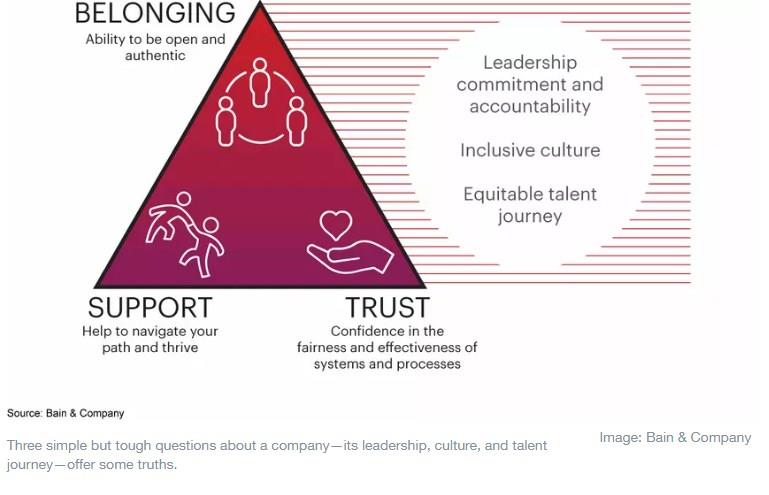by Julie Coffman and Maria Gordian*
A racial reckoning in 2020 prompted many companies, including ours, to acknowledge that existing corporate efforts simply have not done enough to address racial inequity in the workplace or the vast wealth gap between white and Black Americans that reflects and helps reinforce this inequity.
As employers, companies have historically focused their efforts on hiring and job creation. Increasing the number of Black employees clearly matters a great deal. But when we speak to CEOs about their efforts, they consistently cite retention—that is, making sure Black employees stay and thrive—as the biggest hurdle to their diversity, equity, and inclusion goals.
Why is that, and what can companies do about it? Let’s look at the basics that we all need to thrive at work: belonging, support, and trust.
We stay at companies in which we feel we belong and where we can be our authentic selves. Feeling included and valued gives us confidence to speak up and participate. We need support (tools, training, coaching, feedback) to learn and grow in our roles. And we choose to build careers at the companies we trust: our aspirations are stronger if we have faith that the company we work for will fairly recognize and reward our efforts.
This is not the experience of many Black employees today. They see few company leaders who look like them. They often must work harder than their white peers to fit in, expending considerable energy to construct a workplace identity.
As Black employees navigate the unwritten rules of the workplace, they are less likely to benefit from the guidance of sponsors and mentors, who often gravitate toward employees of their own race. And it is naive for leaders to assume that employees who regularly experience systemic racism outside the company will automatically trust the hiring, assessment, and promotion systems inside the company. Companies cannot presume trust; they must earn it.
This, then, is where leaders can start: by taking an honest look at their own company through the eyes of Black employees seeking the belonging, support, and trust that all employees need.
Most C-suites lack diversity, so many executives find it difficult to fully understand the ways their company’s structures, processes, or environment fail to offer belonging, support, and trust in equal measure to all. Three simple but tough questions about a company—its leadership, culture, and talent journey—offer some truths.

First, “Do our company’s leaders consistently demonstrate their commitment and accountability to diversity through our words, our actions, and the diversity of our own team?”
Then, “Do our Black employees’ daily experiences reflect a culture of inclusion and belonging?”
And finally, “Is our talent journey from hiring to promotion, fair, transparent, and trustworthy?”
Finding the answers to these questions starts with the leadership team listening to their employees’ stories and developing a shared awareness of their lived experiences inside and outside of work.
This awareness, coupled with a frank examination of the data around representation, retention, promotion, and employee engagement, can help executive leadership teams develop a common understanding and begin to model the inclusive behaviour that the rest of the organization needs to learn and adopt. It also allows leaders to decide how to measure progress and, importantly, how they will hold themselves and other leaders in the organization accountable for it.
This is not an easy journey for the companies that commit to it. The answers to these questions will make some necessary actions clear, but likely also create many more questions about what additional steps will produce meaningful progress. In our experience, the companies that are advancing down the path with the most clarity and confidence have some behaviours in common:
-Their leaders seek to understand their Black employees’ lived experiences through the lens of belonging, support, and trust.
-A level of awareness, dialogue, and fluency around diversity, equity, and inclusion exists across the entire organization, and leaders at all levels regularly seek to increase it.
-Senior leaders develop and model the inclusive behaviour that is expected of supervisors at every level of the organization.
-Regular feedback on inclusivity, and accountability for it, help to accelerate learning and progress.
-Leaders at all levels regularly scrutinize the outcomes of their talent processes—recruiting, hiring, performance management, and advancement—to ensure that they are equitable.
As leaders examine their own companies, traits such as these are good indicators of whether they are building a diverse, equitable, and inclusive environment—and where they have room to do more. These practices can also be applied to broader diversity, equity, and inclusion efforts as companies continue to improve the workplace for all employees.
Racial diversity, equity, and inclusion is a journey, not a destination. Wherever an organization is on that journey, a focus on belonging, support, and trust is the key to making continuing progress on attracting, retaining, and advancing Black talent. The goal is sustained progress, reaching a bar that is always rising. But there is no better place to start than by creating an environment where all employees thrive.
*Chief Diversity Officer, Bain & Company
**first published in: www.weforum.org




 By: N. Peter Kramer
By: N. Peter Kramer

